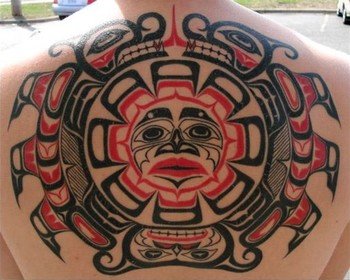Considering the decadence of tattooing in Christian Europe, it might be rightfully noted that the tradition (or at least its prevalence) was reimported with the colonization period and the time of the first great expeditions. Many explorers like James Cook, Jacob Roggeveen, and others reported about heavily tattooed aborigines of Samoa, New Zealand, Borneo, and other regions.
Samoan pea
In Samoa tattoos of males were called pe’a, and they were usually covering the lower body of men from waist to knee, women tattoos, in turn, were called malu and covered the area from the upper thigh to behind the knee (Mallon 2002). As for design, there existed certain main rules to follow, however, each artist had own individual style. Pe’a and malu are often connected with ritualistic ideas of protecting the body, and at the same time making it more beautiful. Those Samoans who carried no tattoos were often referred to as telefua, which means naked. Tattooing pe’a served as an act of transition of young men into competent members of society, and those who could not withstand the pain of the tattooing were labeled as pe’a mutu, which means that they carried marks of shame (Tepapa 2014). Successful passing of this initiation procedure gave young men the right to serve chiefs of the tribe, and in general, both pe’a and malu served as embodiments of manhood and womanhood respectively (DeMello 2007). Moreover, combined with the initiative function, pe’a provided a sense of respect to the bearer from the community and family members.
Maori moko
In New Zealand indigenous people Maori had their way of permanent skin marking which was called moko (Robley 2003). The technique of moko differed from tattooing in the 5 traditional understandings, instead of needles that insert color pigment under the skin Maori used UHI (chisels) that carved the skin. The procedure was extremely painful – first deep cuts were made on the skin, then a chisel with a pigment on it was repeatedly introduced into the cuts, creating lines and shapes. Often the process of tattooing was accompanied by dances and music that helped to relieve the pain, however, the person getting moko could not cry out in pain, this was considered a sign of weakness, which impugned the initiative meaning of moko (Sanders 1989). Moreover, the whole process was considered a sacred ritual, and persons receiving tattoos could be rightfully called “threshold people” (Turner 1969), as during the whole time of tattooing they were not allowed to communicate with anyone not receiving a tattoo, neither were they allowed to eat with their hands. Moreover, tribe members receiving tattoos were restricted from intimate relations (Zealand Tattoo 2009). As for gender division – Maori tattoos were equally given to men and women, however, men usually had full facial tattoos, while women had tattooed lips and chins. In general, moko was a status symbol, not all people were allowed to have it, more than that, only a person of high social ranking could afford moko (Robley 2003). Full facial tattoos served not only as a status symbol – they had a complex communicational function. In a way, male facial moko served as an identification document that could tell about the owner’s social position, marital status, tribe rank, occupation, etc. For this reason, the face was symbolically separated into 8 zones, and each of them had to carry certain information, if, for example, the person had no rank in the tribe, the area responsible for that was left blank (Zealand Tattoo 2009).
Tattoo in Borneo
In Borneo there existed numerous tribes, commonly known as Dayak, share a long history of tattooing practice that pervades different aspects of their lives (Levin 2009). One of the largest native tribes is called Iban, for its members’ tattooing has always been a sacred activity that connected people with the spiritual world. In general, the beliefs of the indigenous people of Borneo tend to be based on the idea of spirituality of the surrounding world that includes nature, animals, and human beings, so mainly natural motives are seen in Dayak tattoo designs. Apart from status and prestige purpose, Bornean tattoos have a religious meaning as well. For example, among Dayak, there is a belief that after death a completely tattooed woman will be allowed to bathe in the mystical river Teland Julan, while women with unfinished tattoos will only be allowed to stand on the bank and those carrying no tattoos at all will not be let to approach the river at all (Levin 2009). Among males, tattooing is often connected with headhunting in both aspects of protection and status (Atkinson 2003). As protective measures, there were used signs on the throat to prevent enemies take over the head of the bearer of the tattoo, and if the warrior in the battle was able to hunt a head of an enemy he was granted to make certain tattoos (Gilbert 2000).
Interestingly, in Dayak culture tattooing has always remained an occupation of women, while men were allowed only to carve woodblocks with tattoo designs that would then be dipped into ink and applied on the skin as a stencil to follow for tattooer. For women, tattoos were part of a decorative purpose and partly served as proof of their talents of singing, dancing, or weaving (Guynup 2004). The complete tattooing of the Dayak woman was a long process, sometimes taking up to four years. The tattooing started at the approximate age of 10 with fingers and feet, proceeding in the next few years up to the point when the whole body is tattooed; this design should have been finished by the woman’s pregnancy as it was considered an undesirable practice to be tattooed after giving birth to a child.
